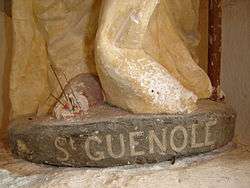Phallic saint
Phallic saints are representations of saints or local deities who are invoked for fertility. The representations of the phallus are benevolent symbols of prolificacy and reproductive fruitfulness, and objects of reverence and especial worship among barren women and young girls.

Description
Phallic saints are representations of actual saints or local deities who are invoked for fertility. More than vulgar representations of the phallus, phallic saints are benevolent symbols of prolificacy and reproductive fruitfulness, and objects of reverence and especial worship among barren women and young girls.[1]
Association
Many are legitimate saints who acquired their priapic attributes through the process of folk etymology. Sir William Hamilton (1730–1803)[2] reported that, among the wax representations of body parts then presented as offerings to Cosmas and Damian at Isernia, near Naples, on their feast day, those of the penis are the most common.[3] Hamiliton's observations led Richard Payne Knight to write his Account of the Remains of the Worship of Priapus, in which he reproduced examples of the effigies.
List of phallic saints
- Ters, or St. Ters, of Antwerp, whose cult was reported on by Johannes Goropius Becanus. He was also named Semini or God Jumenas.
- Saints Cosmas and Damian, twin physicians, one of whose cult-centers was Isernia, in Italy.
- Saint Guignolé (Winwaloe), first Abbot of Landévennec, who acquired his priapic status by confusion of his name with gignere (Fr. engendrer, "to beget").[1] His shrine was not destroyed until 1793.[4]
- Saint Foutin, by assimilation of the name of Pothin (Pothinus), first bishop of Lyon, to the verb foutre (“to fuck”).[1] People worshipped the phallus of St. Foutin by pouring wine on it.
- Saint Guerlichon (Greluchon) at Bourg-Dieu.[1]
- Saint Giles (Aegidius) at Cotentin.[1]
- Saint Rene in Anjou (by confusion with reins, "kidneys" - once believed to be the seat of sexual power).[1]
See also
- Christianity and sexuality
- St. Priapus Church
References
- The Minor Themes, ourcivilisation.com
- Sir William Hamilton was the husband of Emma, Lady Hamilton, the mistress of Horatio Nelson.
- Whitney Davis, Wax Tokens of Libido Archived 2008-05-28 at the Wayback Machine, arthistory.berkeley.edu
- Worship of the Generative Powers: Priapus Worship, sacred-texts.com